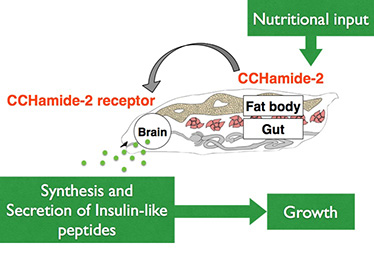
Hiroko Sano, Akira Nakamura, Michael J. Texada, James W. Truman, Hiroshi Ishimoto, Azusa Kamikouchi, Yutaka Nibu, Kazuhiko Kume, Takanori Ida, and Masayasu Kojima (2015). The nutrient-responsive hormone CCHamide-2 controls growth by regulating insulin-like peptides in the brain of Drosophila melanogaster. PLoS Genetics, in press.
nimals need to couple growth with nutritional availability for proper development and physiology, which leads to better survival. Nutritional information is mostly perceived by peripheral organs, particularly metabolic organs such as adipose tissue and gut, before being relayed to the brain, which modulates physiological responses. Hormonal signaling ensures this organ-to-organ communication, and defects in this endocrine regulation in humans often cause diseases including obesity and diabetes. In the fruit flyDrosophila melanogaster, adipose tissue (the “fat body”) has been suggested to play an important role in coordinating growth with metabolism. Here, we show that the Drosophila CCHamide-2 (CCHa2) gene, expressed in the fat body and gut, encodes a nutrient-sensitive peptide hormone. The CCHa2 peptide signals to neuroendocrine cells in the brain that produceDrosophila insulin-like peptides (Dilps) through its receptor (CCHa2-R) and promotes the production of Dilps. Mutants of both CCHa2 and CCHa2-Rdisplay severe growth retardation during larval stages. These results suggest that CCHa2 and CCHa2-R functionally connect peripheral tissues with the brain, and that CCHa2/CCHa2-R signaling coordinates the animal’s growth with its nutritional conditions by regulating its production of insulin-like peptides (Figure 1).

Figure 1: CCHa2/CCHa2-R signaling coordinates growth with nutritional conditions.
CCHa2 expression is up-regulated under fed conditions. CCHa2 activates insulin-producing cells to promote the secretion of insulin-like peptides from those cells, which leads to tissue growth. These results demonstrate that CCHa2/CCHa2-R signaling coordinates the animal’s growth with its nutritional conditions.